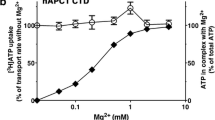Abstract
Sulfate is a partial inhibitor at low and a non-essential activator at high [ATP] of the ATPase activity of F1. Therefore, a catalytically-competent ternary F1•ATP•sulfate complex can be formed. In addition, the ANS fluorescence enhancement driven by ATP hydrolysis in submitochondrial particles is also stimulated by sulfate, clearly showing that the ATP hydrolysis in its presence is coupled to H+ translocation. However, sulfate is a strong linear inhibitor of the mitochondrial ATP synthesis. The inhibition was competitive (K i=0.46 mM) with respect to Pi and mixed (K i=0.60 and K′i=5.6 mM) towards ADP. Since it is likely that sulfate exerts its effects by binding at the Pi binding subdomain of the catalytic site, we suggest that the catalytic site involved in the H+ translocation driven by ATP hydrolysis has a more open conformation than the half-closed one (βHC), which is an intermediate in ATP synthesis. Accordingly, ATP hydrolysis is not necessarily the exact reversal of ATP synthesis.
Similar content being viewed by others
References
Abrahams P, Leslie AGW, Lutter R, Walker JE (1994) Nature 370:621–628
Adachi K, Oiwa K, Nishizaka T, Furuike S, Noji H, Itoh H, Yoshida M, Kinosita Jr K (2007) Cell 130:309–321
Ahmad Z, Senior AE (2004) J Biol Chem 279:31505–31513
Allison WS (1998) Acc Chem Res 31:819–826
Ariga T, Muneyuki E, Yoshida M (2007) Nat Struct Mol Biol 14:841–846
Bald D, Amano T, Muneyuki E, Pitard B, Rigaud J-L, Kruip J, Hisabori T, Yoshida M, Shibata M (1998) J Biol Chem 273:865–870
Bayles Scanlon JA, Al-Shawi MK, Phi Le N, Nakamoto RK (2007) Biochemistry 46:8785–8797
Berden JA, Hartog AF (2000) Biochim Biophys Acta 1458:234–251
Bianchet MA, Hullihen J, Pedersen PL, Amzel LM (1998) Proc Natl Acad Sci U S A 95:11065–11070
Börsch M, Diez M, Zimmermann B, Reuter R, Gräber P (2002) FEBS Lett 527:147–152
Botts J, Morales M (1953) Trans Faraday Soc 49:697–707
Boyer PD (1993) Biochim Biophys Acta 1140:215–250
Boyer PD (1997) Annu Rev Biochem 66:717–749
Bowler MW, Montgomery MG, Leslie AGW, Walker JE (2007) J Biol Chem 282:14238–14242
Chen C, Saxena AK, Sincoke WN, Garboczi DN, Pedersen PL, Ko YH (2006) J Biol Chem 281:13777–13783
Cross RL (2000) Biochim Biophys Acta 1458:270–275
Diez M, Zimmermann B, Börsch M, Köning M, Schweinberger E, Steigmiller S, Reuter R, Felekyan S, Kudryavtsev V, Seidel CAM, Gräber P (2004) Nat Struct Mol Biol 11:135–141
Ebel RE, Lardy HA (1975) J Biol Chem 250:191–196
Ferguson S, Lloyd WJ, Radda G (1976) Biochim Biophys Acta 423:174–188
Foster JF, Sterman MD (1956) J Am Chem Soc 78:3656–3660
Fromm JH (1969) Methods Enzymol 63:467–485
Gao YQ, Wang W, Karplus M (2005) Cell 123:195–205
Gibbons C, Montgomery MG, Leslie AGW, Walker JE (2000) Nature Struct Biol 7:1055–1061
Hartog AF, Edel CM, Braham J, Muijsers AO, Berden JA (1997) Biochim Biophys Acta 1318:107–122
Jault J-M, Allison WS (1993) J Biol Chem 268:1558–1566
Jaworek D, Gruber D, Bergmeyer HU (1974) In: Bergmeyer HU (ed) Methods of enzymatic analysis, vol. 4. Academic, New York, pp 2127–2129
Kabaleeswaran V, Puri N, Walker JE, Leslie JE, Mueller JE (2006) EMBO J 25:5433–5442
Kagawa R, Montgomery MG, Braig K, Leslie AGW, Walker JE (2004) EMBO J 23:2734–2744
Knowles AF, Penefsky HS (1972) J Biol Chem 247:6617–6623
Kotlyar AB, Vinogradov AD (1990) Biochim Biophys Acta 1019:151–158
Lamprecht D, Traustschold I (1974) In: Bergmeyer HU (ed) Methods of enzymatic analysis, vol. 4. Academic, New York, pp 2101–2110
Lodeyro AF, Calcaterra NB, Roveri OA (2001) Biochim Biophys Acta 1506:236–243
Lowry OH, Rosebrough AL, Farr LH, Randall RJ (1951) J Biol Chem 193:265–275
Menz RI, Leslie AGW, Walker JE (2001a) FEBS Lett 494:11–14
Menz RI, Walker JE, Leslie AGW (2001b) Cell 106:331–343
Milgrom YM, Cross YM (2005) Proc Natl Acad Sci U S A 102:13831–13836
Mitome N, Ono S, Suzuki T, Shimabukuro K, Muneyuki E, Yoshida M (2002) Eur J Biochem 269:53–60
Nakamoto RK, Baylis Scanlon JA, Al-Shawi MK (2008) Arch Biochem Biophys 476:43–50
Noji H, Yasuda R, Yoshida M, Kinosita Jr K (1997) Nature 386:299–302
Pacheco-Moisés F, Minauro-Sanmiguel CB, García JJ (2002) J Bioenerg Biomembr 34:269–278
Pänke O, Gumbiowski K, Junge W, Engelbrecht S (2000) FEBS Lett 472:34–38
Pedersen PL (1975) Biochim Biophys Res Commun 64:610–616
Penefsky HS (1974) J Biol Chem 249:3579–3585
Penefsky HS (1977) J Biol Chem 252:2891–2899
Perez JA, Ferguson SJ (1990) Biochemistry 29:10503–10518
Pullman ME, Penefsky HS, Data A, Racker E (1960) J Biol Chem 235:3322–3329
Recktenwald D, Hess B (1977) FEBS Lett 76:25–28
Ren H, Allison WS (2000) Biochim Biophys Acta 1458:221–233
Rondelez Y, Tresset G, Nakashima T, Kato-Yamada Y, Fujita H, Takeuchi S, Noji H (2005) Nature 433:773–777
Roveri OA (1985) Biochem Int 11:11–19
Roveri OA, Calcaterra NB (1985) FEBS Lett 192:123–127
Senior AE, Nadanaciva S, Weber J (2002) Biochim Biophys Acta 1553:188–211
Shirakihara Y, Leslie AGW, Abrahams JP, Walker JE, Ueda T, Sekimoto Y, Kambara M, Saika K (1997) Structure 6:825–836
Suranyi EV, Avi Dor Y (1966) Biochim Biophys Acta 118:445–452
Syroeshkin AV, Vasilyeva EA, Vinogradov AD (1995) FEBS Lett 366:29–32
Vinogradov AD (2000) J Exp Biol 203:41–49
Walker JE, Dickson VK (2006) Biochim Biophys Acta 1757:286–296
Weber J, Senior AE (2003) FEBS Lett 545:61–70
Wong JT-F (1975) Kinetics of enzyme mechanisms. Academic, London, pp 39–70
Wong S-Y, Matsuno-Yagi A, Hatefi Y (1984) Biochemistry 23:5004–5009
Xing J, Liao J-C, Oster G (2005) Proc Natl Acad Sci U S A 102:16539–16546
Yagi K, Osawa T (1960) Biochim Biophys Acta 42:381–387
Yonetani T, Theorell H (1964) Arch Biochem Biophys 106:243–251
Zharova TV, Vinogradov AD (2006) Biochemistry 45:14552–14558
Author information
Authors and Affiliations
Corresponding author
Rights and permissions
About this article
Cite this article
Lodeyro, A.F., Castelli, M.V. & Roveri, O.A. ATP hydrolysis-driven H+ translocation is stimulated by sulfate, a strong inhibitor of mitochondrial ATP synthesis. J Bioenerg Biomembr 40, 269–279 (2008). https://doi.org/10.1007/s10863-008-9177-3
Received:
Accepted:
Published:
Issue Date:
DOI: https://doi.org/10.1007/s10863-008-9177-3




